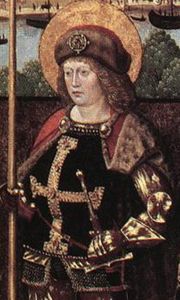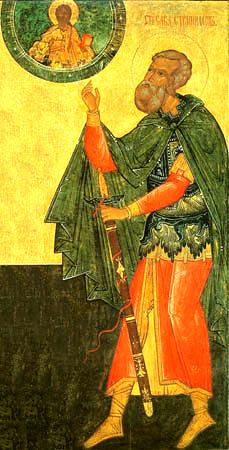Related Research Articles

Agnes of Rome is a virgin martyr, venerated as a saint in the Catholic Church, Oriental Orthodox Church and the Eastern Orthodox Church, as well as the Anglican Communion and Lutheran Churches. She is one of several virgin martyrs commemorated by name in the Canon of the Mass.

Saint Bibiana is a Roman Virgin martyr. The earliest mention in an authentic historical authority occurs in the Liber Pontificalis, where the biography of Pope Simplicius (468–483) states that this pope "consecrated a basilica of the holy martyr Bibiana, which contained her body, near the 'palatium Licinianum'". The Basilica of Santa Bibiana is dedicated to her.

Saint Apollonius the Apologist or Saint Apollonius of Rome was a 2nd-century Christian martyr and apologist who was martyred in 185 under the Emperor Commodus (161-192).
Cyriacus, sometimes Anglicized as Cyriac, according to Christian tradition, is a Christian martyr who was killed in the Diocletianic Persecution. He is one of twenty-seven saints, most of them martyrs, who bear this name, of whom only seven are honoured by a specific mention of their names in the Roman Martyrology.

August 3 - Eastern Orthodox liturgical calendar - August 5

August 11 - Eastern Orthodox liturgical calendar - August 13

Saint Juliana of Nicomedia is said to have suffered Christian martyrdom during the Diocletianic persecution in 304. She was popular in the Middle Ages, especially in the Netherlands, as the patron saint of sickness.

Saint Benignus of Dijon was a martyr honored as the patron saint and first herald of Christianity of Dijon, Burgundy. His feast falls, with All Saints, on November 1; his name stands under this date in the Martyrology of St. Jerome.

Saints Primus and Felician (Felicianus) (Italian: Primo e Feliciano) were brothers who suffered martyrdom about the year 304 during the Diocletian persecution. The Martyrologium Hieronymianum gives under June 9 the names of Primus and Felician who were buried at the fourteenth milestone of the Via Nomentana (near Nomentum, now Mentana).

Gereon of Cologne, who may have been a soldier, was martyred at Cologne by beheading, probably in the early 4th century.

Symphorosa is venerated as a saint of the Catholic Church. According to tradition, she was martyred with her seven sons at Tibur toward the end of the reign of the Roman Emperor Hadrian (117–38).

Saints Victor and Corona are two Christian martyrs. Victor was a Roman soldier who was tortured and killed; Corona was killed for comforting him. Corona is invoked as a patron of causes involving money; she was not historically associated with pandemics or disease, but has been invoked against the coronavirus pandemic.
Rictius Varus was a Vicarius in Roman Gaul at the end of the 3rd century, around the time of the Diocletianic Persecution. The Roman Martyrology contains many references to the prefect Rixius Varus, who is said to have persecuted hundreds of Christians. In Christian hagiography he later repented and became a Christian martyr himself, and is regarded a Saint in the Eastern Orthodox and Roman Catholic Churches, with his feast day on July 6.
Basilides and Potamiaena were Christian martyrs now venerated as saints. Both died in Alexandria during the persecutions under Septimius Severus.

Basilissa and Anastasia are early Christian martyrs of Rome, put to death during the reign of Nero. They were among the first converts to Christianity in the 1st century after Christ.

Agapitus is venerated as a martyr saint, who died on August 18, perhaps in 274, a date that the latest editions of the Roman Martyrology say is uncertain.

Saint Sabbas Stratelates, Sabbas the General of Rome was an early Christian warrior saint and martyr, was Roman military general under emperor Aurelian. He is the 'twin' of Saint Sabbas the Goth. His martyrdom was followed by 70 Roman soldiers.

Christina of Bolsena, also known as Christine of Bolsena, or in the Eastern Orthodox Church as Christina the Great martyr, is venerated as a virgin martyr of the third century. Archaeological excavations of an underground cemetery constructed over her tomb have shown that she was venerated at Bolsena by the fourth century.

December 9 - Eastern Orthodox liturgical calendar - December 11

December 20 - Eastern Orthodox liturgical calendar - December 22
References
- ↑ Saint Juliana Archived 2009-09-15 at the Wayback Machine Patron Saint Index
- ↑ Saint Paul Archived 2009-09-15 at the Wayback Machine Patron Saint Index